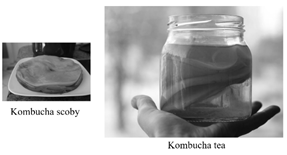- Submissions

Full Text
Journal of Biotechnology & Bioresearch
Kombucha and Kefir are Foods of the 21st Century: A Opinion
Karina Teixeira, Magalhães-Guedes1*, Talita Andrade, da Anunciação1 and Rosane Freitas Schwan2
1 Federal University of Bahia-UFBA, Brazil
2 Federal University of Lavras-UFLA, Brazil
*Corresponding author:Karina Teixeira Magalhães-Guedes, Federal University of Bahia - UFBA, Brazil
Submission: July 10, 2019;Published: July 16, 2019

Volume2 Issue1July, 2019
Opinion
Kefir is a fermented milk product having slight acidic taste, carbonation, and aroma good. The kefir beverage contains a specific mixture of microorganisms (lactic bacteria, acetic bacteria e yeast) that reside in symbiotic manner in a kefiran polysaccharide matrix. Kefir grains (Figure 1 & 2) can be characterized as small cauliflower florets, having a length of 10-40mm, irregularly shaped, white to yellowish in color, having firm texture and slimy appearance. The kefir microorganisms have a capacity to produce organic acids, antibiotics, and numerous types of antimicrobials; these substances have a lethal effect on pathogenic microorganisms of the body. Kefiran is an exopolysachhardie component of kefir grain that has significant importance in human health and nutrition [1,2].
Figure 1:Kefir-grains and beverage.

Figure 2:Kombucha-scoby and tea.

kefir beverage is being used as prophylactic to lessen the threat of allergy, gastrointestinal diseases, and hypertension [3]. Kefir beverages also find acceptance for infants and preschoolers as naturais diet. kefir is efficient in lowering infections of small intestine in young ones and infants. Based on these nutritional claim’s kefir beverage can be classified as naturais probiotic resource.
consumed for its beneficial effects on human health. This nutritive beverage has been consumed in many countries for a very long time, and today interest is growing because scientific reports indicate that kombucha tea could prevent chronic diseases. Kombucha has a beneficial effect such as antibiotic properties, regulation of gastric, intestinal and glandular activities, relief of joint rheumatism, gout and hemorrhoids, positive influence on the cholesterol level, arteriosclerosis, toxin excretion and blood cleansing, diabetes, nervousness, and aging problems.
Nutritive ability of kombucha tea can be explained by the formation of iron and gluconic acid, which increases the level of blood hemoglobin and stimulates Adenosine Triphosphate (ATP) synthesis. Vitamin C synthesized by kombucha tea, can enhance absorption on nonheme (plant-derived) iron. Vitamin B group also synthesized by kombucha tea can promote the enzymatic activation for lipid and protein metabolism. The Central Oncological Research Unit in Russia have conducted population investigations on kombucha tea and have determined that consumption of this beverage on a daily basis has correlation with resistance to cancer [4]. The kombucha tea modulates immunity and prevents cancer proliferation at early phase of hormone-dependent tumor cell growth, due to the synergetic action of kombucha tea symbiosis. May have an effect against breast cancer. The potential health benefits of kombucha tea in humans are vast and potentially important for population health.
There is a growing trend to consume nutritional food products having health benefits among various segments of mark on every part of this globe. This desire directed the consumption of kefir and kombucha in daily diet. Due to high nutraceutical and therapeutic potential, kefir and kombucha are ranked at top position as foods of the 21st century.
References
1. Amarasinghe H, Weerakkody NS, Waisundara VY (2018) Evaluation of 473 physicochemical properties and antioxidant activities of kombucha “tea fungus” during 474 extended periods of fermentation. Food Science and Nutrition 6(3): 659-665.
© 2019 Karina Teixeira Magalhães-Guedes. This is an open access article distributed under the terms of the Creative Commons Attribution License , which permits unrestricted use, distribution, and build upon your work non-commercially.
 a Creative Commons Attribution 4.0 International License. Based on a work at www.crimsonpublishers.com.
Best viewed in
a Creative Commons Attribution 4.0 International License. Based on a work at www.crimsonpublishers.com.
Best viewed in 







.jpg)






























 Editorial Board Registrations
Editorial Board Registrations Submit your Article
Submit your Article Refer a Friend
Refer a Friend Advertise With Us
Advertise With Us
.jpg)






.jpg)














.bmp)
.jpg)
.png)
.jpg)










.jpg)






.png)

.png)



.png)






